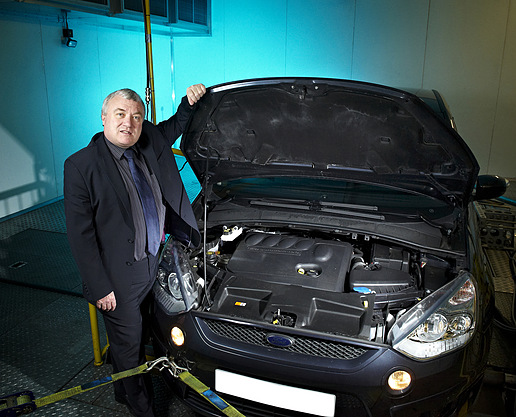目前两所英国顶尖科技大学正在牵头进行的两个研究项目,一是通过设计来降低催化转换器的成本,另一个是通过更先进的涡轮增压与燃烧技术来降低发动机的排放。
在伦敦的帝国理工学院,化学工程学院的研究员Benjamin Kingsbury博士正在领导团队开发生产流程,以达到大批量生产一款新型催化转换器的目的,旨在提高汽车燃油效率,并降低生产成本。
而巴斯大学动力传动系统与车辆研究中心(PVRC)正在开展一个由政府和企业界共同投资的“绿色汽车”项目,该项目总资金达到1.33亿英镑, 由该研究中心新设立的高级推进中心(APC)负责实施。PVRC中心曾主导研发了福特汽车1.0-L I3 EcoBoost发动机。APC由英国汽车协会与行业共同建立,汇聚了先进传动技术领域的优秀人才,研究领域包括改进燃油效率、降低碳排放、以及将技术转化为产品等等。
催化剂载体的改进
Kingsbury博士与Kang Li教授、Zhentao Wu博士一起着手进行催化转换器的研发,后两位教授也是帝国理工学院化学工程学院的研究员。早期的测试显示,这项技术可将燃耗降低3%左右,而二氧化碳的排放也会随之降低。
Kingsbury博士表示,他们研发的催化转换器设计可以减少80%的贵金属(铂族元素)用量,这将大大降低生产成本。此外,该设计还能减轻整个寿命周期内的材料劣化。通常,稀有金属占到一个催化转换器成本的70%。而在10万公里(161,000mi)的测试中,新系统只显示出4%的劣化率,而一个普通的催化转换器的材料劣化率则高达35%。
帝国理工学院的一位发言人表示,Kingsbury博士已经就该系统与数家汽车公司进行了接触。同时,他还成立了一家帝国理工学院下属的创业公司,负责对系统进行市场推广。
Kingsbury博士表示,他们并未对汽车中的“Cats(三元催化器)”的基本设计做重大改变,因为这项技术在上世纪70年代中期就已经成为美国轻型汽车排放控制系统的一部分,并在十年后被普及到欧洲。他们所做的,是在设计中加入了闭环反馈机制,对原设计进行了提升,通过将氮氧化物转化成氮气和水,大大降低了颗粒物的排放。
“我开发的原型可以降低汽车的运行成本,因为它的燃油用量降低了,”Kingsbury表示。“它可以帮助汽车制造商降低成本,节约燃油成本,并最终降低二氧化碳的排放。”
Kingsbury说,他还对一个现有的制造工艺进行了改进,以优化转换器的蜂窝状基材的结构。这一改进的原理,是通过增加基材表面积来提高稀有金属的分布效果,并减少其用量。增大基材表面积还可以增强系统的化学反应,降低排气背压。
帝国理工学院的一篇新闻稿称,Kingsbury博士已经获得英国皇家工程院的资助,用于该系统的市场推广。
与福特合作的ACTIVE项目
作为福特ACTIVE(先进涡轮增压燃烧内嵌式可变气门机构发动机)项目的11名研究合作伙伴之一,巴斯大学的PVRC获得了120万英镑的投资。该项目的中心研究项目是1.0-L EcoBoost发动机,目前该发动机已经应用到福特的数个车型上。
这一项目的出发点是为帮助加速下一代低碳技术推出市场,这项技术旨在通过先进涡轮增压和燃烧系统的开发,辅以尖端的可变气门机构技术,实现降低二氧化碳排放的目标。
PVRC的汽车工程学讲师Sam Akehurst博士解释说:“PVRC在福特的ACTIVE项目中的主要任务是研究新型涡轮增压器和新型可变气门正时技术的基本性能与互动机制。我们将研究由于排气阀开启时每个气缸的排空所造成的发动机排气脉动气流和涡轮增压机构的相互作用机制。”
这一研究将通过两种方式完成:第一种是直接在发动机上进行研究,第二种是借助PVRC正在研发的一种独特的“热脉动涡轮增压气站(hot pulsating turbocharger gas stand)”进行研究。这两种方法都能支持高级模拟技术的验证,以帮助福特公司了解怎样才能最好地利用这些新科技。
“研究的目的是同时优化发动机和涡轮增压器的性能,从而使发动机扭矩、燃油经济性和瞬态响应的整体状况都达到最佳水平。” Akehurst博士告诉《汽车工程》期刊的记者。
巴斯大学工程与设计学院院长兼PVRC主任Gary Hawley教授补充道:“我们对该项目的参与延续了我们对EcoBoost发动机研发的巨大贡献。”他表示,这些成果都是建立在巴斯大学在降低汽车发动机二氧化碳排放方面,特别是在模拟复杂技术与系统的性能和表现方面的实力之上的。
福特的ACTIVE研究项目的参与方包括4所在汽车技术研究方面居于领先地位的英国大学(巴斯大学、拉夫伯勒大学、布拉德福德大学和诺丁汉大学),部件和设备供应商,如大陆、舍弗勒、UEES, Cambustion、AP Raicam,以及像英国石油(BP)这样的能源公司。
Reducing the cost of catalytic converters through design, and reducing engine-out emissions using advanced turbocharging and combustion techniques, are the focus of recent U.K.-based research projects spearheaded by two leading technical universities.
At Imperial College, London, Dr. Benjamin Kingsbury, a Research Associate in the Dept. of Chemical Engineering, is heading a project to develop a production process for high volume manufacture of a new catalytic converter aimed at both improving vehicle fuel consumption while offering production cost savings.
And the University of Bath’s Powertrain and Vehicle Research Center (PVRC), which had a significant role in the development of Ford’s 1.0-L I3 EcoBoost engine, is taking part in a £133 million government-and-industry-backed “greener cars” program. The work is being carried out by the new Advanced Propulsion Center (APC), a joint industry and government body established by the U.K. Automotive Council to become a hub of excellence for advanced powertrain technology, including improvements to fuel efficiency and reduction in carbon emissions — and to migrate technologies into products.
Catalyst substrate improvements
Dr. Kingsbury developed the catalytic converter together with Prof. Kang Li and Dr. Zhentao Wu, who are also with Imperial College’s Dept. of Chemical Engineering. Early tests indicate a potential fuel consumption benefit of around 3%, with a complementary reduction in CO2 emissions.
Dr. Kingsbury said the catalytic converter’s design uses up to 80% less precious metals (platinum group), which brings significant cost reduction. The design is also said to suffer less through-life degradation. Typically, rare metals represent up to 70% of the cost of a catalytic converter. Laboratory tests indicate a 4% deterioration over 100,000 km (161,000 mi) for the new system, compared to a claimed 35% deterioration for a regular catalytic converter.
A spokesperson for Imperial College says Kingsbury has been in contact with several auto industry companies regarding the new system. He has initiated an Imperial start-up company to market it.
According to Kingsbury, the fundamental design of automotive "cats" has not significantly changed since the technology became an integral part of light-vehicle emissions control systems in the mid-1970s in the U.S., and in Europe about a decade later. The adoption of closed-loop feedback capability improved the original design by markedly reducing emission of particulates via conversion of NOx into nitrogen and water.
“The prototype I have developed could make cars cheaper to run because they use less fuel," Kingsbury said. "It could potentially help manufacturers to reduce their costs and it could also save on fuel costs and ultimately lead to reduced CO2 emissions.”
He explained that he has advanced an existing manufacturing process to improve the structure of the catalytic converter’s honeycombed substrate. The effect is to increase the surface area, which facilitates the rare metals being distributed more effectively and fewer being required. The increased surface area also results in an enhancement of the system’s chemical reaction process. Exhaust back pressure is also reduced, he claimed.
Dr. Kingsbury has received funding from the Royal Academy of Engineering to take his system to the marketplace, according to a release from Imperial College.
Project ACTIVE with Ford
At the University of Bath, the PVRC has been awarded £1.2m to carry out research as one of Ford’s 11 partners on Project ACTIVE (Advanced Combustion Turbocharged In-line Variable Valvetrain Engine), which centers on the 1.0-L EcoBoost, now powering several of the company’s models.
The basis of the project is to help accelerate the introduction of future generation low-carbon technologies aimed at reducing CO2 via advanced turbocharging and combustion system development, complemented by highly sophisticated variable valvetrain technology.
Dr. Sam Akehurst, Lecturer in Automotive Engineering at the PVRC, explained: “The PVRC's role in the Ford-led ACTIVE program is to investigate the fundamental performance and interactions of a new type of turbocharger with new variable valve timing technology. We will study how the turbocharger interacts with the pulsating flow in the engine exhaust due to the blow-down events that occur from each cylinder as the exhaust valve opens."
This will be done in two ways—on engine and by utilising a unique hot pulsating turbocharger gas stand that the PVRC is developing. Both of these methods will support the validation of advanced simulation techniques aimed at assisting Ford in making decisions on how best to use the new technologies.
"The objectives are to optimise the performance of the engine and turbocharger in unison to achieve best performance in terms of overall engine torque, fuel economy and good transient response,” Dr. Akehurst told Automotive Engineering.
Prof. Gary Hawley, Dean of the Engineering and Design faculty, and Director of the PVRC, added: “Our involvement in this project continues the high impact contribution that we made to the development of the EcoBoost engine.” He said it builds on the University’s capability to emulate the performance and behavior of complex technologies and systems to drive down the car-engine CO2 footprint.
Along with Ford, the ACTIVE project involves four of the U.K.’s leading automotive research universities (Bath, Loughborough, Bradford, and Nottingham), as well as component and equipment suppliers including Continental, Schaeffler, UEES, Cambustion, AP Raicam, and the energy company BP.
 巴斯大学动力传动系统与车辆研究中心主任Gary Hawley教授
巴斯大学动力传动系统与车辆研究中心主任Gary Hawley教授 A test cell at the University of Bath's research facility.
A test cell at the University of Bath's research facility.